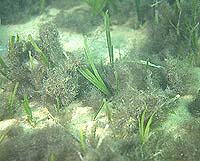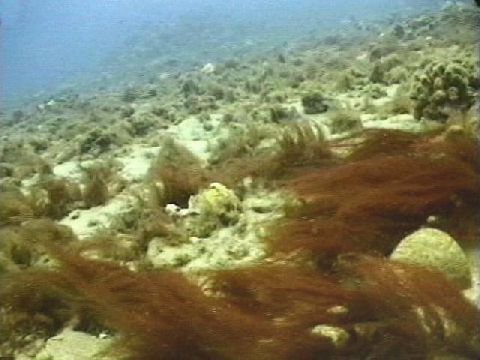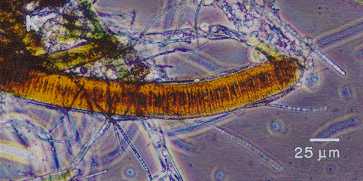STINGING LIMU - STINGING SEAWEED
 STINGING LIMU
STINGING LIMU
- STINGING SEAWEED

By Susan Scott
July 29, 1996
Stinging seeweed season is here;
try to steer clear

STINGING limu season is upon us. A few weeks ago, a dermatologist told me he suspected this seaweed was the cause of a blistering rash on the stomach of a girl swimming off the Waianae Coast. Soon after, the state Health Department received reports of swimmers afflicted with rashes from stinging limu along the Mokapu Peninsula, Kailua Beach and Ewa.

People in Hawaii call a variety of marine organisms stinging limu, but only one true seaweed is known to commonly cause a rash in humans here. This blue-green seaweed, called Lyngbya majuscula (or sometimes Microcoleus lyngbyaceus) usually grows in clumps, looking like dark, matted masses of hair or felt. Most often this seaweed is blackish-green or olive-green, but it also grows in shades of gray, red or yellow.

The filaments of this seaweed grow up to 4 inches long, often tangling with other seaweeds on reef flats, in tide pools or water as deep as 100 feet. When loose in the water, this seaweed looks like floating, tangled strands.
The toxicity of this seaweed varies greatly depending upon region, season, and type. Not all strains of this seaweed are toxic.
WHEN toxic, stinging limu contains two potent, inflammatory toxins, both causing skin damage upon contact. Typically, seaweed fragments get caught inside swimsuits, rubbing these toxins into the skin.
Epidemics of this seaweed-induced rash occasionally occur in both Hawaii and Okinawa. In Hawaii, the highest number of cases occur from June through September in windward swimming areas. Persistent trade winds blowing during these summer months may dislodge the seaweed from the bottom. Fragments then drift into swimming bays and beaches.
The Health Department issues public warnings when outbreaks of this rash occur in swimmers. Heed these warnings. Common areas are Kaneohe Bay, Kailua Bay and waters off Laie and Ewa, but the seaweed grows and drifts in other areas too.
LIMITING swimming time in affected areas does not guarantee protection, nor does the prompt removal of your bathing suit. If you come in contact with the stinging variety of this stuff, you will likely end up with a rash.
Rash victims feel an itching and burning sensation minutes or even up to 24 hours after leaving the water. A red, sometimes blistering rash occurs, sometimes in an entire swimsuit pattern. Most surfers are all too familiar with this seaweed, which can wash down the suit and irritate the most tender of body parts.
Such a rash also can occur on the face and in the eyes and mouth. Some victims have swelling of eyes and mouth, but no rash.
For mild to moderate cases of skin rash, remove your swimsuit immediately and wash skin vigorously with soap and water. Wash the suit, too.
ALTHOUGH unproven, cool compresses or rubbing alcohol may help relieve the pain. For persistent itching or skin rash, doctors recommend trying 1 percent hydrocortisone ointment four times a day, and one or two 25 milligram diphenhydramine (Benadryl) tablets every six hours. These drugs are sold without prescription. Diphenhydramine may cause drowsiness, so don't drive, swim, or surf after taking it.
Irrigate exposed eyes with tap water for at least 15 minutes. For severe discomfort, blistering not responding to first-aid treatment, eye stings, or any signs of infection, see a doctor.
Any difficulty breathing signals an allergic reaction, which is always a medical emergency.
Other marine organisms, including tiny jellyfish and flatworm larvae, can cause similar-looking skin rashes. Distinguishing these from this seaweed rash often is impossible.
The good news, however, is that treatment is the same.
Susan Scott is a marine science writer and author of three books about Hawaii's environment. Her Ocean Watch column appears Monday in the Honolulu Star-Bulletin.
© Copyright 1996 by Susan Scott.
All rights reserved.
Used with her express permission.
